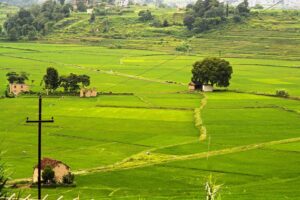Time is frozen in Khokana, an antiquated city eight kilometres from Kathmandu’s chaotic city centre. Wander here and feel as if you’ve stepped into the medieval age—the huddled settlement surrounded by farmland and the impenetrable hill to the south, with the Bagmati River in its lap.

The village is believed to be blessed by Sikali Devi (one among the thirty-three million gods and goddesses of Hinduism) and has a fascinating tale on the origin of its name. Legend has it that a Maharjan priest – a Hindu-Buddhist Newar caste group of Nepal – who was pronounced dead came back to life seconds before his cremation, with his wife as ‘Sati’- a Hindu practice in which the wife is burnt in the funeral pyre of her husband. Despite the miracle, the couple was not allowed back in the village. They then ran away, weeping and narrating their sad story to strangers they met along the way and settled in the present-day Khokana – the word Khokana means ‘weeping while telling’.
According to Newari culture, two large ponds, Pale Pukhu on the left and Kha Pukha on the right, symbolise a hearty welcome and good luck.
The village resembles the shape of the Swastika – the symbol of peace, prosperity and good fortune, not to be confused with the infamous Nazi symbol. The Nazi symbol is oriented with the arms pointing to the right, while that of Hinduism is oriented with the arms pointed to the left, along with four dots in each square.
While Khokana covers an area of 2,7 square kilometres, only a fraction is occupied by the residential area; the remaining is used for agricultural fields and cultural festivals. The town appears as a cluster of houses, closely packed together in the middle of lush fields, with a wide cobbled street. Both sides of the street are lined with houses of exposed fair-faced bricks and mud mortar, with ponds and chowks (crossroads).
You might also like
The village resembles the shape of the Swastika – the symbol of peace, prosperity and good fortune, not to be confused with the infamous Nazi symbol.
The public courtyard (Lachhi) is centrally located in the settlement, beside the giant temple and a Buddhist stupa. King Amar Malla built the temple in the 16th Century. The stupa was built by Maurya King Ashoka—an Indian emperor renowned for constructing the Ashoka Pillar at Lumbini, which serves as a testament to the birthplace of Gautam Buddha. De Pukhu is the main pond in the Lachhi, where the goat festival is celebrated yearly during Gaijatra.
The temple beside the Lacchi is the famous Rudrayani Temple, built in the pagoda style. On the upper floor, the temple houses idols of eleven deities, including Mahakali, Kali, and Ganesh. There is also a temple of Shrikhand with a peculiar rule—the offering of garlic is prohibited. People of Khokana do not raise pigs and chickens because offering these animals is strictly forbidden in the temple. The temple is being renovated again, as the 2015 earthquake severely impacted it.
The eye-catching terrace farming of Khokana reveals that agriculture is the primary source of income. The plain below the settlement in the west, which also has a local name, Doh Phat, is presumably the most fertile land in the entire nation. The mustard crop is the village’s speciality, and mills there produce the finest mustard cooking oils. During the rule of the Shahs and Ranas (circa 1768-1951 AD), the royals and elites in the Kathmandu valley
used mustard oil produced in Khokana.
In 1996, picturesque Khokana was also nominated to be listed as a UNESCO World Heritage Site. It represents a vernacular village and its mustard-oil seed industrial heritage. Khokana is also home to the very first house with electric lights in South Asia.
The people of Khokana follow another peculiar tradition of celebrating Janku. Janku is a ritual festival first performed when people reach a certain age. Legend has it that some people who live as long as 106 years have celebrated five Jankus.
The first Janku is performed at the age of 77 years, 7 months and 7 days, the second at the age of 83 years, 4 months, and 4 days, the third at 88 years, 8 months, and 8 days, the fourth at 99 years, 9 months, 9 days and the last one at the age of 105 years, 8 months, and 8 days. Once all five Jankus are performed, they represent an incarnation of God.
Pratikshya Bhatta is a junior editor with Nepal Connect




